Zurich is the world's best city to live in, with the highest quality of life, according to some recent studies -- so it is also a perfect place to visit. While most people know its reputation as a modern banking center, you will be surprised to discover the historic charms of its extensive Old Town, among the largest in Switzerland, and the glamor of the modern shopping streets.
Visitors can take pleasure in this great lifestyle, enjoying friendly, efficient services while exploring many fascinating sights. With just under 400,000 people, Zurich is an ideal place to stay -- especially when you consider the main visitor attraction, which is a beautiful Old Town of cobbled lanes lined with historic buildings and numerous fine shops and restaurants.
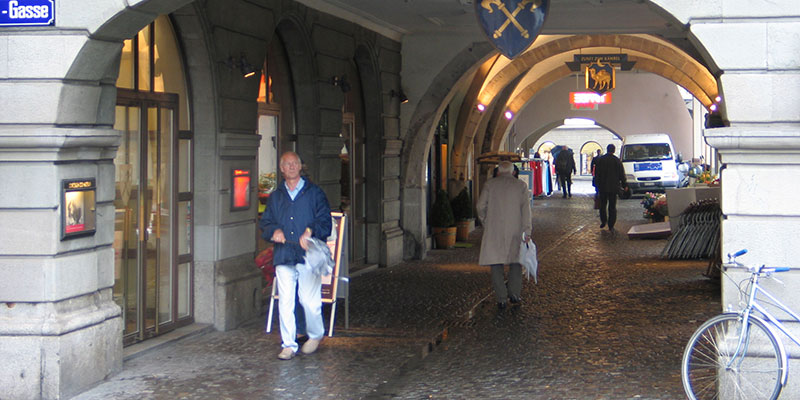
It is delightful to wander in this large pedestrian zone that is filled with enchanting little alleys which lead though an ancient town that was founded during the Middle Ages. With the right strategies you can see this slightly expensive city without spending a fortune. It's an easy city to cover on foot, which is always the best and cheapest way to see any historic town.
Zurich has been ranked in the top-ten most expensive cities in the world -- third most expensive city in Europe and second most expensive city in Switzerland after Geneva. And yet Zurich residents have the world's strongest purchasing power, primarily because of their high incomes. Don't be scared away thinking Zurich will be too expensive to visit, because the hotel and food prices are quite similar to Europe's other major cities, and there is a lot you can do here for free, such as walking around, which is the main activity we will be showing here.
As usual, we find walking tours are the best way to see a city, and it is easy here because the center is not large, only about one square kilometer, yet rich with a tangle of dozens of little lanes, major boulevards, historic sites and waterfront promenades.
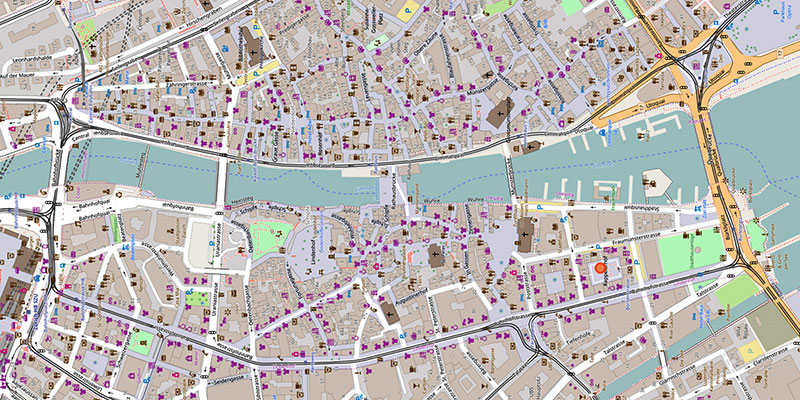
Showing you on the map of Zurich how the Old Town is really divided in two parts on either side of the Limmat River. In this page we focus on the Old Town on the south side of the river. This charming, compact city is situated on the picturesque waterfront shores of Lake Zurich, with the Limmat River running through the center of town. And the city embraces the riverfront coming through town with some lovely walkways and many vistas across this watery landscape.
The Old Town extends about five blocks in from both sides of the river and stretches for about a mile in length, so it's very extensive. The right bank, or east side, of the river has the larger cluster of old buildings and is considered the prime district for visitors. Much of your first day can be devoted to exploring its many little side alleys and shops.
.jpg)
Many visitors arrive by train so a typical starting point is the centrally located main train station. It's got more trains running through it than any other station in the world and there is a big shopping mall downstairs. Average daily passenger count is 400,000 with that world record of nearly 3000 daily trains.
The modern side of Zurich is most impressive when you emerge from the train station you are right at the end of the Bahnhofstrasse, the main street of town. This is a glamorous Boulevard, broad, tree-lined and for pedestrians and trams, so you don't have any automobile or truck traffic on the Bahnhofstrasse. It's a very comfortable place to stroll about. It goes for nearly a mile from the train station down to the lake and there some small plazas along the way and great sidestreets for exploring. See our other Zurich page for detailed description of this modern side. Of all Swiss cities Zurich has the largest combination of modern and Old Town districts, very extensive, from the sleek upscale shops of Bahnhofstrasse to the narrow lanes of the big historic zone.
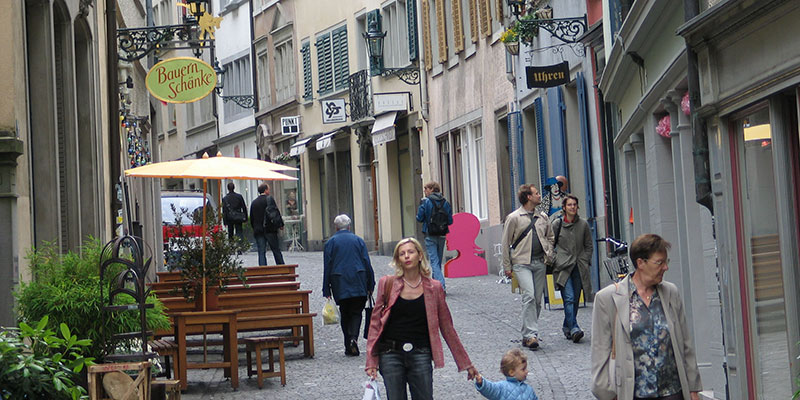
We're going to show you how to spend the day on an in-depth walking tour of Zurich traveling around in a big circle starting out from the train station, circling around and ending up back at the station in the evening. There are many little side lanes to explore and places to just go wandering on your own, but we will give you a general outline of a best single route in which to take. The route we're going to take you now is to leave the station and walk around into the Old Town first, down through Niederdorf, then continuing around in a clockwise fashion ending up at the Bahnhofstrasse modern street.
For most visitors it's the Old Town that has that special attraction, and so therefore it's worth doing it first before you run out of time and energy and will be time at the end to see some of the modern city as well, which we will be presenting in our other page on Zurich. Here we're going to show you the Old Town in depth.
.jpg)
We're heading to the largest part of the Old Town which is across the Limmat River just a few hundred meters from the train station. In two blocks you'll reach the east side of the Limmat River and there you'll find the beginning of Niederdorfstrasse, the longest lane in the Old Town.
Your main itinerary could be summarized as simply wandering up and down nearly every little lane in the Old Town, which is an ideal version of the best imaginable collection of historic buildings set amid a delightful tangle of narrow, cobblestone pedestrian alleys. Disney could not have done it better, but this is the real thing. Leave it to the Swiss to preserve their past and maintain these 500-year-old buildings in perfect condition. There is not a single ugly or boring moment to break the spell.
For help in locating the various sights and streets it's always good to have a map whenever you wander through little lanes so that you know what you have covered and where to go next; otherwise, you might end up going in circles, wasting time and getting slightly lost. Free maps are widely available from hotel desks and the Tourist Information office at the main train station.
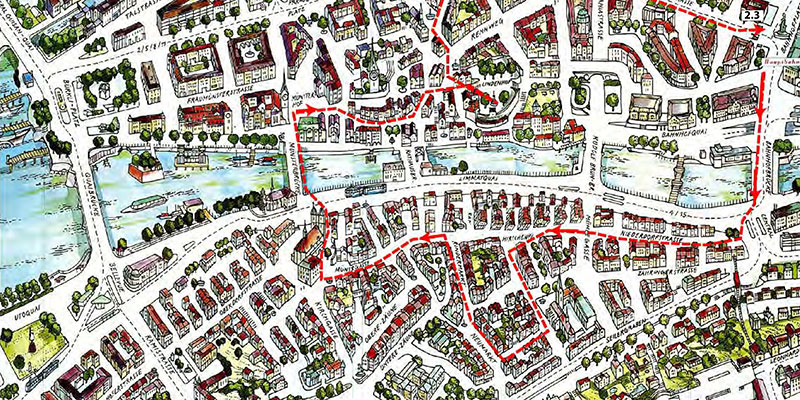
In particular, there is an excellent hotel in the heart of the Old Town, the Adler, and they have got a lively and colorfully detailed map of the Old Town. You might inquire and take a look at that hotel while you're checking it out. It's also useful -- and can lead into some interesting conversations -- to ask directions from the locals, who are quite friendly and generally speak English. You don't really really have to have a map, it's a small enough old town, and you could just walk along the main lane, but you do want to explore the little side lanes and that's really where the map can come in handy.
We shall walk the lanes along Niederdorfstrasse in a route that we’ll be taking as we wiggle our way around, and will be explaining all of this to you right now. If you are exploring on your own, you don’t need to follow this exactly, but these are the main lanes that you’ll want to try and find.
.jpg)
We're standing in the heart of the Old Town of Zurich now. This is the Niederdorfstrasse and it's truly one of the great streets in the world. It's a pedestrian street nearly a mile long and there's all kinds of characters here. You're going to see an international crowd on the street as well as mostly locals, and there is of course a lot of restaurants, sidewalk restaurants and bars, cafes, bakeries, there's hotels here such as the Hotel Alexander, very conveniently located. And this is the main thoroughfare of the Old Town of Zurich. There are side streets that are also really fun to walk along.
You go up a few blocks and across and then back down to Niederdorfstrasse and it's a bit of a maze when you get into some of those little back lanes as well as going back across the river, across the Limmat to the newer part of town where the Banhofstrasse is at and most of the banks and department stores and major shops and the ultra-luxury shops, the Gucci and the Hermes. And that too has a nice chunk of Old Town, again focused along the water's edge.
.jpg)
There's some fine dining that could be enjoyed here or just simple inexpensive food like donner kebabs sandwiches, take-out sausage, you don't have to spend a fortune here in Zurich, even though Zurich is known as a fairly expensive city, prices are relatively high, but Zurich is also noted as a city with a very high quality of life. It’s a wonderful place to raise a child even though it's quite urban. They really take care of the kids here, and there are playgrounds of course and great schooling. Swiss education is among the best in the world.
So its got that quality of life which is measured by things like income level which is quite high here, health statistics, mortality, age of living, as well as the facilities available, education, health facilities, and such. Zurich is right there at the top in the world.
.jpg)
Paved with cobblestones and lined with historic buildings hosting modern shops, cafes and restaurants, Niederdorfstrasse is a place to linger and enjoy. Sometimes it widens to form small plazas as it intersects with other lanes, but mostly it is just about twenty feet across. This medieval street curves here and there, and rises then drops slightly as it continues in a most pleasant pattern.
It has been the main lane of Zurich since the Middle Ages and is still the major route for visitors to explore today. And the label Niederdorf applies not just to the street but to the neighborhood in general. Niederdorfstrasse stretches for nearly one mile from the train station area to beyond the cathedral and is limited to pedestrians the entire way. Typical of European streets, it changes names a few times, becoming Munstergasse, Hirschenplatz and Oberdorfstrasse, but it is basically the same road throughout.
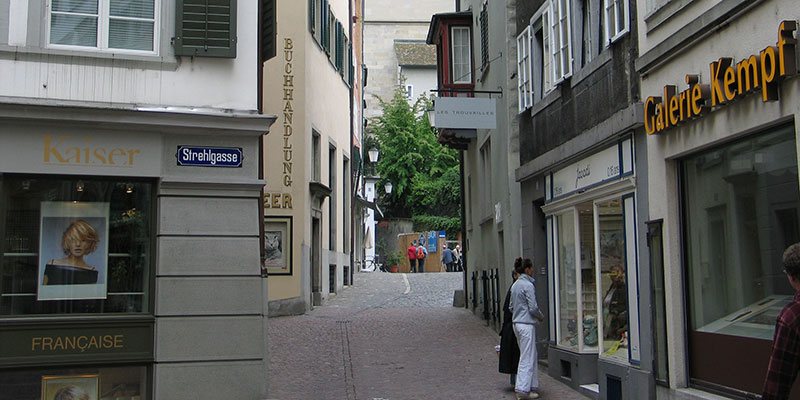
Dozens of small lanes branch off both sides leading further into the magic of the Old Town. The neighborhood is just the right size: small enough so you cannot get lost or disoriented or exhausted but large enough to keep you discovering new sights for a couple of days. You can easily fill out an afternoon by meandering through this fascinating network of alleys, exploring the little shops and enjoying the variety of traditional Swiss buildings.
Anyplace you turn along this main pedestrian route of Niederdorfstrasse in the central heart of the Old Town is a delight but there are several exceptionally picturesque lanes you want to be sure to look for, especially around the mid-section where the street widens to form the connected plazas of Hirschenplatz and Stussihofstatt. Hirschenplatz has blossomed into an ideal urban plaza ringed by outdoor restaurants and two excellent hotels, the 3-star Adler and 4-star Wellenberg.
.jpg)
This plaza was created in the 1870s, as part of the redevelopment of the Prediger district to open up some space in the narrow, confined lanes of the lower Old Town. Hirschenplatz is one of the main open spaces in the center of the Old Town, with various lovely lanes branching off from it and several more of those nearby plazas easily reached on foot in minutes from here.
Walk the broad, tree-lined block of Spitalgasse to the gothic Prediger Church which dates from about the year 1230, with its mix of later baroque decor and the town's tallest tower reaching up 300 feet. The neo-Gothic tower was built at the end of the 19th century. Today the Zähringerplatz plaza in front of Predigerkirche functions mostly as a car park, but there is a peaceful outdoor restaurant on the adjacent terrace.
Several fine alleys lead away from the church plaza, including the narrow Predigergasse and Brunngasse. Maybe it seems like nothing special but when you walk along past shops and galleries, it comes alive. Predigergasse is a lovely skinny little alley, the kind that forms a real surprise for you, and it's quite useful because it connects one interesting part of the Old Town with another and there's some art galleries along here, there are some residences and various little shop so be sure to find Predigergasse.
.jpg)
After meandering through these lanes, walk to Neumarkt, one of the town's finest junctions which dates back to about the year 1145 and still has some original buildings, especially the famous Grimmenturm, a 12th-century gothic tower with a popular restaurant in front, Kantorei.
The square-like open space in front of the restaurant constitutes a focal point on the Neumarkt and also marks the boundary between the Neumarkt and the Rindermarkt, the street just beyond.
First mentioned in documents dating from 1145, the Neumarkt is considered one of the Old Town's most picturesque streets. During the Middle Ages, the Neumarkt served as a cattle market. The excellent historic preservation of the buildings lining the Neumarkt and their relevance to architectural and artistic history contribute considerably to the diverse character of Zurich's historic center.
The prominent Grimmenturm tower standing above the other structures was partly destroyed in 19th century renovations and only in the 1960s was it restored as the distinctive feature of the Old Town.
At the beginning of the 20th century, it was decided that this property, as well as many other houses near it in the Old Town, should be torn down to make room for a new road through the central city. Fortunately, that misguided project was rejected and the neighborhood as survived.
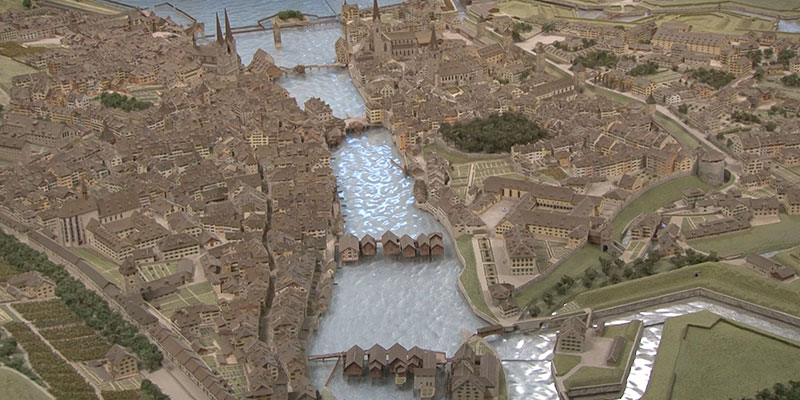
A hidden gem of the Neumarkt is a historic display, concealed behind an unmarked door on the left side of this plaza. There is no sign out front but look for Number 4 on the door, which leads into the City and there you will find a free display of Zurich's history including a scale model of the Old Town's evolution, clearly illustrating how Niederdorfstrasse was the first street of early Zurich and really demonstrating how the buildings and the patterns of the streets that we see today in the Old Town are just about the same as they were back in the Middle Ages. It's really quite remarkable to see this 3-D model, something you would never expect. There's no sign out front on the door saying come on inside to look at our display so you have to look for door number four right across from the fountain at the Neumarkt. The exhibits here are part of the city archives. A look at the medieval town wall model with its towers becomes a nostalgic journey into Zurich's past.
Multimedia touch-screen displays have been added to provide the visitor further historical information. You can play with that and learn something at the same time with the pictures, maps and text. There are also many old photo displays and a reference library covering all aspects of Zurich's past cultural life.
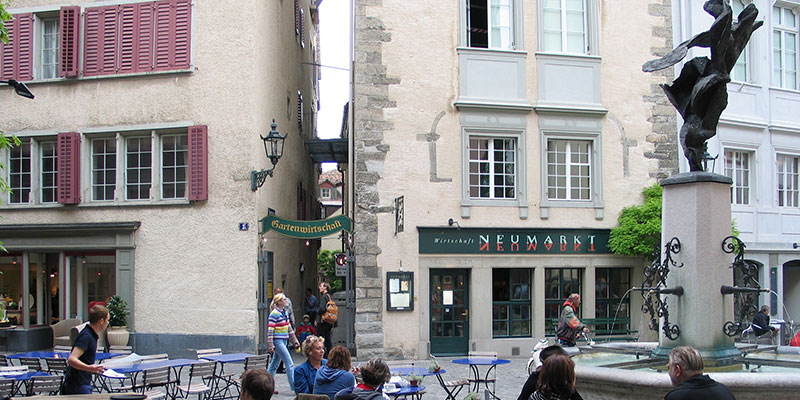
Leading from Neumarkt, the Rindermarkt is an important ancient lane linking back to the Niederdorf (the Lower Old Town) where it connects up with Stussihofstatt, another main plaza in the Old town.
The name Rindermarkt means cattle market which was its function back in the Middle Ages, 1300s when it got started. Now it’s a lane of unique shops, individually owned. It's a very historic street, the only one in Zurich with gaslamps still functioning -- would make a perfect evening stroll. It's a picturesque side lane that most tourists never discover.
Browsing the shops in these little lanes can be one of the great pleasures of your trip even if you're not looking to buy anything and you don't even really need to go into this shops if you don't want, just look at the window displays, each one is unique. This is different than going to a big shopping mall or one of the modern streets with all of the famous name brand stores. These are individual boutiques and delightful little galleries individually owned and expressing all of the quirks and passions of their owners.
Another typical small lane is Froschaugasse. Now you could easily walk past this without even noticing it or glance down it and blink and just skip on by, but lanes like this can be worth a little detour. You don't have to go all the way down, just to take a few steps if you're interested, keep going and you might be delighted.
.jpg)
These scenes do bring out the essence of the back lanes of Zurich and why among many other reasons it's such a wonderful place to visit. If this doesn't appeal to you, you can stick to the main boulevards, there are quite a few here in Zurich, but most visitors enjoy getting off the beaten track like this.
These little detours can provide memorable moments to really enrich your experience, like stopping to pet a stranger's dog, and it speaks to the value of taking your time and spending a few days in a place when you get there is such a Zurich. Sure, you could see Zurich in one day. Everything we’re showing, every place, every boat ride and tram ride could be done in one day, but you would get a better experience by spending at least a couple of days here with some time to enjoy music. We’ve just been walking on Brunngasse and before that the lane called Froschaugasse. You can easily discover all these alleys for yourself.
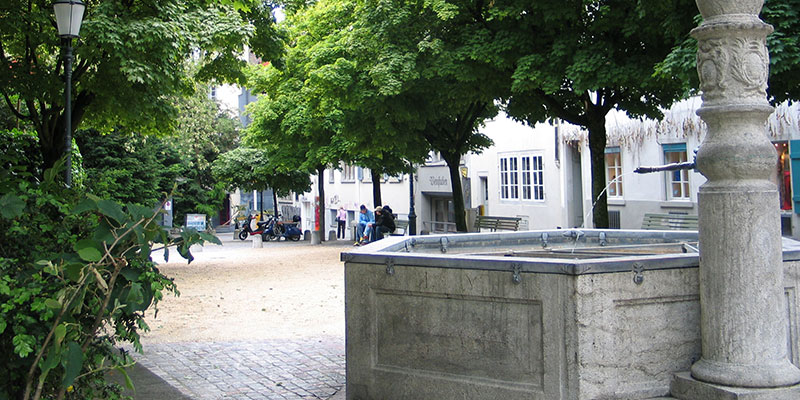
This small Spiegelgasse has been home to some famous people, such as Lenin, who lived here for one year immediately prior to the Russian Revolution. This is where he was doing the planning. A charming spot with cozy restaurant, historic buildings and a beautiful fountain centerpiece.
The next plaza is Leuengasse also host to a pretty little fountain. This is where people would get their drinking water in the old days, a good place for kids to play and adults to relax. Soon you'll easily find yourself out of this twisted maze of back alleys returning to the main pedestrian lane. You'll want to drop into some of the stores in this district to see what treasures are hiding behind their windows. A gallery on Munstergasse offers a typical range from contemporary to antique, with photos, paintings and old master drawings.
.jpg)
One food shop you would enjoy is Schwartzenbach, selling dried fruits, nuts, fresh-roasted coffee beans, chocolate and many gourmet treats, with a casual cafe on the corner and sidewalk tables. They are especially famous for the highest quality fresh roasted coffee beans from all over the world but as a traveler you’re probably more interested in the dried fruits. These make great purchases for snacking as you walk along or for a casual light picnic later on, and they have such a wide variety of the dried pears and apples and bananas, dried wild strawberries and there is a lot of nuts, and they’ve also got foods in jars like pates and jams and tees as well, so you gotta stop in and spend a little money.
.jpg)
Upon leaving Schwartzenbach look to the other side of the lane for another food discovery. This hidden gem is the Cafe Schober, set back from the road behind bushes, but worth finding or its pastries, tea service, dark Teuscher chocolates, and a festive 19th century interior. Easy to find and well worth your time, it's located in what's called the Great Alcove right along Niederdorfstrasse.
Here you'll find one of the most famous cafes in Europe. It's been in business for over 120 years. Now this might hurt your eyes to look at all of these beautiful pastries, incredible. We are in Cafe Schober, highly recommended. They do have some different dining areas. You can sit downstairs in the cafe but we much prefer the elegant tea salon with the red velour upholstery and the beautiful red theme and wood beams in the ceiling.
It can make a very nice break when you're walking around with friends to sit down at a cafe like that and enjoy an hour sitting, not standing, not walking, having coffee or hot chocolate and just regaining your energy for the walks that are yet to come
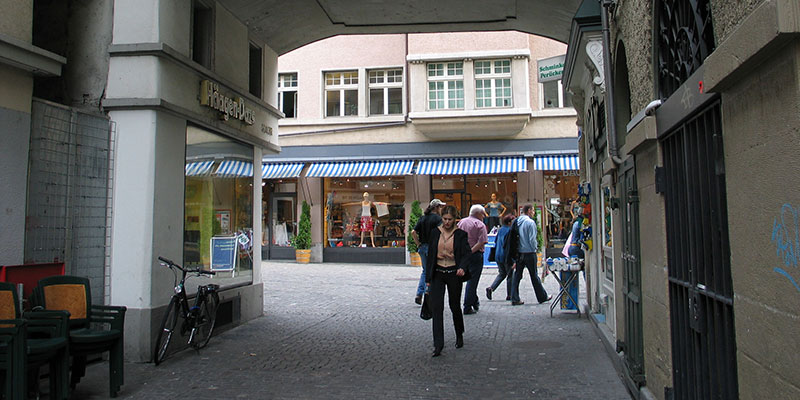
This pedestrian lane just keeps on going block after block. It's like a mile and a half from one into the other but it seems like 3 miles, there are so many interesting things to have a look at. You'll be stopping, window shopping, maybe have a drink or two along the way and always lots of people watching.
As you continue along the main pedestrian lane of the right bank you will reach the major historic site of town -- the Great Cathedral, or Grossmunster, a huge Romanesque church dating back to the year 1106. This is where the Protestant Reformation began in Switzerland with the fiery sermons of Huldrych Zwingli in 1519, two years after Martin Luther began his crusade in Germany.
.jpg)
The Grossmunster cathedral is Zurich's most famous landmark. According to legend, Charlemagne built the first church here as a monastery and chapter school. Construction of the current building was from about 1100 to 1300 in the Romanesque style. The monumental Romanesque interior is rather plain, stripped of all pictures during the Reformation, but be sure to appreciate the stained glass.
The crypt is an original Romanesque portion of the church, downstairs and just behind the altar, be sure to go down and have a look. Centerpiece is a large statue of Charlemagne sitting with a mighty, two-edged sword upon his knees, and a gilded crown upon his head, but the figure is oddly proportioned, but the statue is a good-natured, stumpy affair, that brings a smile. That ubiquitous emperor certainly manifested great interest in Zurich. About midway up one of the towers, a copy of this statue appears again on the exterior in a lofty niche.
.jpg)
The remarkable Romanesque cloister back adjoining the church was restored with infinite pains, and is well worth a visit. If you were here 100 years ago you would have heard the vaulted cloisters resound with merry laughter, and see the girls play tag around the carved columns because a girls' school was built here in 1853. Today it is a quiet oasis in the midst of the city, but the inconspicuous door is easily overlooked and often locked.
Built in a Romanesque style and yet this was the time period in which the Gothic was already getting started in France. Switzerland was a little behind the times architecturally and yet created one of the world's great churches. You’ll benefit from walking all the way around it to see it from the various angles. Typical of Europe's ancient cathedrals, it's surrounded by the best parts of the old town with many lanes to explore.
Naturally a lane called Kirch-Gasse or Church Street is one of those just behind the church and it is another lovely place to go wandering. It's got sidewalk cafes, there is a downhill slant to the cobblestone lane, you can sit outside, have a beer, have some Thai food or just walk by.
Oberdorfstrasse is a continuation of that main pedestrian lane that began as Niederdorfstrasse and it just keeps going down here below the great Cathedral, just south of the Cathedral, more shops, there are little side lanes, there are little cafes still yet down in this area, and it goes for another five or six little blocks so you might as well explore it all. There's some nice window shopping to be had here. You might not be purchasing these big items but shoes might come in handy, especially if you're climbing up a staircase street. There's an interesting side lane with a beautiful mural covered with an ivy wall. Instead of graffiti, Zurich does have some lovely artistic wall murals, that is a much better alternative. And notice the clever design of the hill side lane, smooth on one side and steps on the other, you can take your pick.
.jpg)
And always a few more art galleries scattered around. We have arrived down by the riverside at Schifflände and there are some clothing stores. You might think Switzerland is just too expensive for normal shopping but you'll be surprised, you'll find some good sales. You can always run into a clearance where you'll get a bargain. It is a lovely couple of blocks. So you want to have a walk through this little plaza on your way over to the river. It's a relatively remote corner of the Old Town that does not attract very many tourists, so you're very much into the local scene here.
It's that kind of neighborhood with an easy-going authentic feeling with shops for locals but doesn't show up in guidebooks, a place that most visitors never bother to get to, and yet when you're over here walking around surrounded by residents of the city it makes you feel like you belong, if only for a moment.
.jpg)
This leads to the embankment along the river which is another delightful place to explore. Here you’ll find outdoor restaurants and more shops and a long medieval-style arcaded sidewalk. If you're feeling at all hungry or thirsty, there are numerous choices here ranging from fast food to the ultra-gourmet. Before the construction of embankments along the Limmat, the arcades saw a bustle of activity, such as loading and unloading fish and cargo, and a series of major headquarters for the merchants were built here.
The guild houses, together with the other imposing buildings lining the right bank of the Limmat, provide an impressive view, including a nice perspective on the old Town Hall, still functioning today. Guilds were like our modern union, an association of craftsmen or merchants who played an important role in running of the town in previous centuries. From the Middle Ages on, the guilds established themselves along the river, which explains the considerable number of large guild houses in the area. Many of them have become excellent restaurants featuring a refined cuisine in splendid, historic rooms. You would probably enjoy a traditional meal of sliced veal with cream gravy, mushrooms and rosti potatoes. Up on the hill behind you can spot some of the buildings of the University of Zurich. You can take a tourist boat ride on the river but it is more interesting to ride the excursion boat on Lake Zurich, as we'll show you in our other page about downtown.
.jpg)
There is a convenient bridge right in front of the Grossmunster Cathedral that will bring you across the river in just a couple of minutes. Then turn back and have a look at the magnificent view of the high towers and some traffic on the river.
We are spilling across the river now towards the modern side of town, but on this north side of the Limat there are also several blocks of the "Old Town" that we describe here.
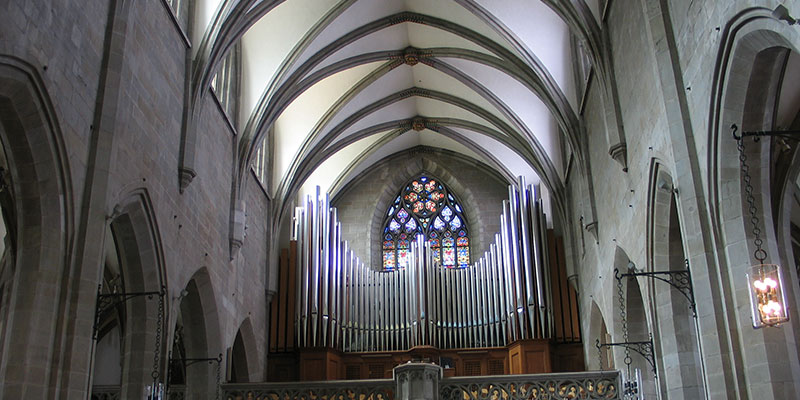
Continue walking a few short blocks to Fraumunster, another of the major churches and Zurich's oldest building, dating back to the late 9th century. It began as a flat-roofed Romanesque convent and was expanded into a gothic church around the year 1280. The striking pattern of pointed arches inside is overshadowed by the church's main treasure -- stained glass painted by Marc Chagall when he was in his 80s.
Fraumunster Church was originally a convent for aristocratic women from southern Germany. It was founded in 853 by Charlemagne's grandson, King Ludwig the German for his daughter Hildegard; He endowed that King Henry III grant the convent the right to hold markets, collect tolls, and mint coins, effectively made the abbess the ruler of the city. Now it’s parish is the towns smallest because it’s in the financial center, but it’s still going after 1200 years.
.jpg)
Following another twisty and curvy route up the hill of Lindenhof for a view and then we will walk over to the main street, the Bahnhofstrasse, and say goodbye to you there. In part two of our look at Zurich we will show you the Bahnhofstrasse in detail, so be sure to look for that other page.
You can take a stroll along the riverbank on this nice promenade with a waterfront view including a nice vista looking back at the Munster, a church so big you have to gain some distance to see the whole thing. The Wuhre is a pedestrian passageway along the river, with several narrow lanes branching off, and some retail including a popular cafe. The walkway is so hidden away you might not notice it, or you might think it is private, but it is open to the public. In the old days there was no walkway, just a riverbank where they would unload the goods.
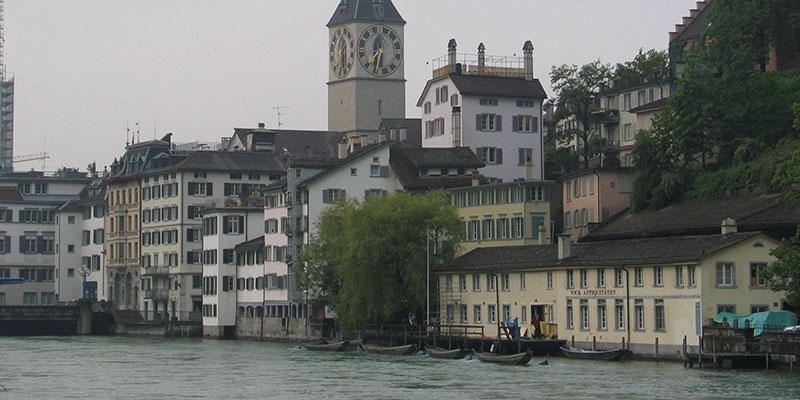
This embankment continues along the river where it changes name to Schipfe and leads past the arcade cafe at the elegant Hotel Storchen, a perfect place to have a drink while admiring the view across the Limmat. This riverfront neighborhood is the oldest core of Zurich, dating back to settlements over 2000 years old. This brings you to an open space in front of the hotel called the Weinplatz, a lovely setting for another Terrace Cafe and why not a glass of wine after all it's the wine plaza. These peaceful venues offer a moment of relaxation, away from traffic yet only a few blocks from busy downtown.
The Storchengasse shopping lane with its select shops, merits special attention. Around the middle of the 19th century, the open market stalls were gradually, that replaced by shops, and large shop windows were installed on the ground floors of the mostly medieval houses lining the narrow street. Teuscher is an upscale confiserie that specializes in chocolatte truffles. This is one of three outlets in Zurich, also found on Bahnhofstrasse and the Jelmoli Department Store.
This neighborhood is generally called Lindenhof because we’re just at the base of that hill that we will be walking up in a moment. It's a little tangle of retail shopping lanes; nothing particularly special in these few streets but just go wander and keep your eyes open and enjoy the shop fronts, people watching, and always there's some dogs going by. The Swiss just love their dogs. Often you'll see dogs without a leash but they always seem to be with their masters so they're very well trained. These are Swiss dogs after all and the masters look out after them, but sometimes these guys get rowdy when they see some of their neighborhood friends.
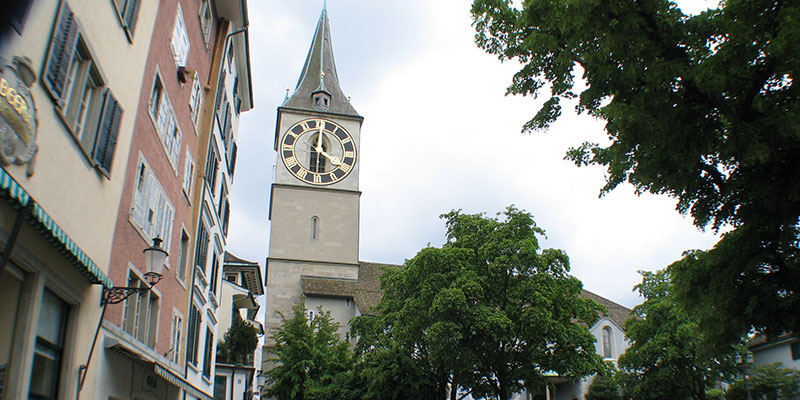
In the midst of this special network of alleys you can't miss the towering steeple of St. Peter's Church with Europe's largest clock: twenty eight and a half feet across, 500 years old and still keeping accurate time. The quiet little square next to the church is one of the most charming spots in town.
.jpg)
Continuing along to Lindenhof, a small park on top of the hill. Now here's a tip for getting up there. There is a staircase which is rather steep and long or you can walk around the backside of it up a more gradually sloping pedestrian lane and then have a short staircase, so that's a better way to get there. The park is one of the most famous places and popular and recreational areas in the heart of the city, one of Zurich’s main attractions.
From Lindenhof you gain the best view across the river to the main section of the Old Town, where you will notice the tall spires of the Grossmunster, Zurich's main church and signature sight, along with several other church steeples and beautiful buildings along the riverfront.
It is still used today as a very active park by the locals. One of their favorite activities up here is playing chess with big chess pieces, and it is quite a spectator sport as folks gather around to watch the moves. You also can find ping-pong and petanque, the ballgame sometimes called bocce or boule, one of the favorite recreational games throughout Europe.
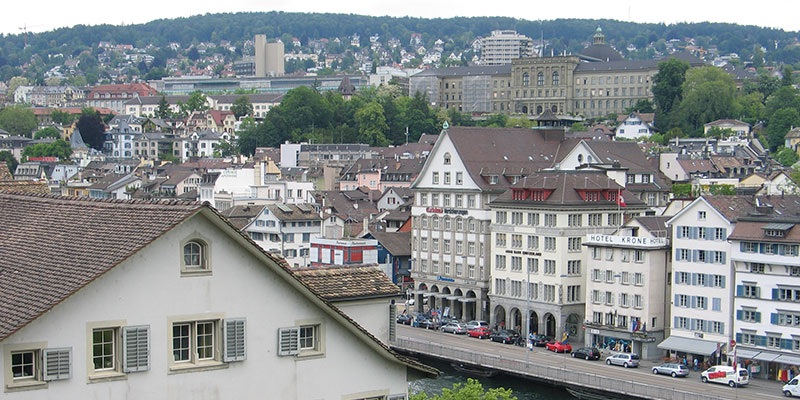
Lindenhof is one of those rare special places that are enjoyed by the local residents and by the savvy visitors. It's not easy to find when you're traveling around, so you have to know what you're looking for. Then you might be rewarded with a sublime experience of the view, a beautiful park with lime trees, and locals hanging out and socializing having fun together. You'll notice the big chess set provides opportunity for more than a game, but for the neighborhood to get together and have some fun.
While today Lindenhof is a park, in the past it was occupied by a variety of important buildings, from the early Roman fortress surrounded by a wall with twelve towers, to a major medieval palace which was demolished in the 13th century during a citizen revolt. Since then, further construction has been forbidden to preserve it as a small urban park. It was the only park in medieval times, when one of the main recreational activities here was shooting crossbows.
One focal point is the Hedwig fountain. It recalls a historical legend from the year 1292: while all the men of Zurich were away at war, Duke Albert attacked the unprotected city with his troops. It was the brave women of Zurich put on armor, grabbed swords and lances and drove the Austrian army away. Hedwig was the leader of these women and she's depicted in the helmeted figure on top of the fountain which was erected in 1668.
The city actually began at Lindenhof. Like many European cities, Zurich was founded by the Romans, who set up headquarters on this hill as an outpost for their expanding empire. The hilltop area of Lindenhof is listed as a Swiss heritage site of national significance because of its prehistoric, Roman, and medieval remains. A Roman tombstone from the second century was found here, with the earliest written record of the Roman name for the town, they called Turicum. The original is in the Swiss National Museum.
Exit Lindenhof down the south steps along Platzgasse. At the foot of the Lindenhof hill you face a maze of five little alleys radiating out in all directions, but don't worry about which way to go: this is a good place to get used to the idea you are going in every direction.
This cluster of alleys is really one of the nicest parts of the city, so walk a few short blocks along one route and circle back along a different lane to where you started, and then pick another circuit.
In wandering you'll undoubtedly come upon Rennweg, which is the biggest street in this part of the Old Town, and it has been one of the main streets of the city ever since Roman times. It's still an attractive thoroughfare lined with shops and restaurants and really geared more for local people. It's a practical place for them to go shopping so you would probably enjoy this authentic lane to stroll up and down.
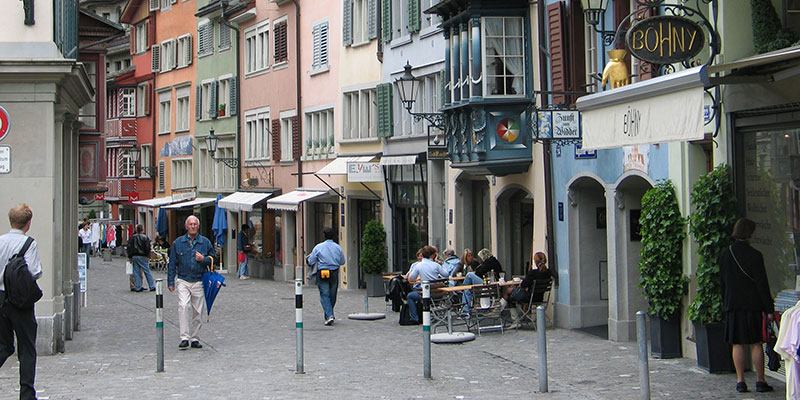
Be sure to have a good look at Augustinergasse, which has a perfect atmosphere of ancient buildings arrayed on a gentle curved path, luring you along by revealing more charming structures until it reaches the busy Bahnhofstrasse. If you spend enough time walking around on the streets you’re going to run into some nice musical entertainment, and if you really get lucky, you might hear an Alpine horn concert. [music]
This Italian restaurant operated by the famous wine family is ranked number 10 out of 1500 restaurants in Zurich by Trip Advisor. In the evening, especially around that magical hour of twilight, the same streets take on a wonderful glow with a mix of shop lights, sunset and streetlamps. You will be dazzled. [music] And perhaps we’ll get lucky and run into some wonderful street musicians.
If your schedule allows for it, try and be out walking on the street at this particular time of day. No matter where you are in Europe, it's always rewarding.
You can also watch the video on the dedicated video page.